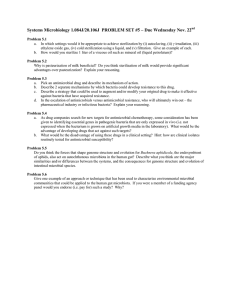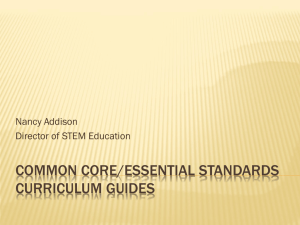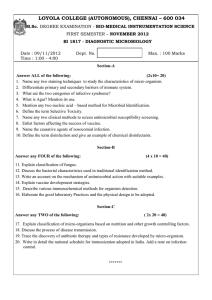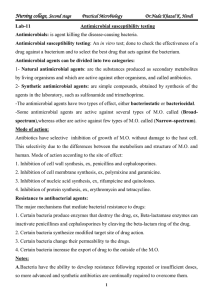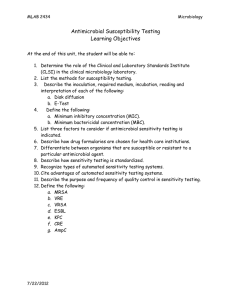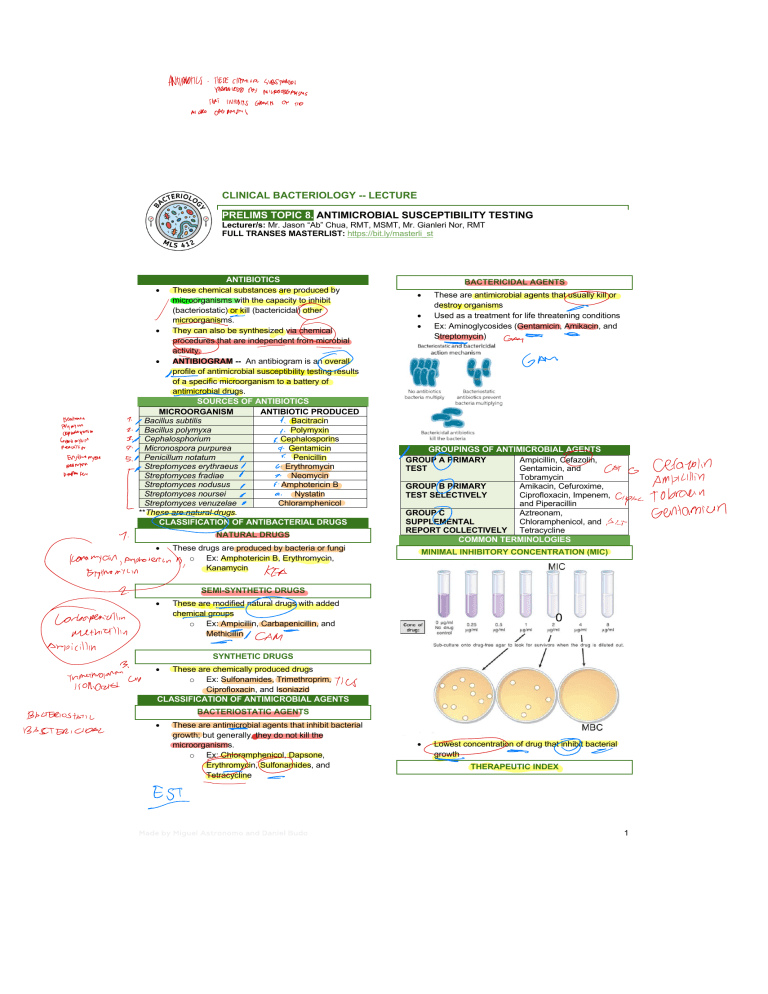
ANTIBIHLS · TESE CHEMICAL SUBSTANCES prebio By MILPORSENSMS NAT Micks IIHIBIS GKOMA of 1158 RGANISM] CLINICAL BACTERIOLOGY -- LECTURE PRELIMS TOPIC 8. ANTIMICROBIAL SUSCEPTIBILITY TESTING Lecturer/s: Mr. Jason “Ab” Chua, RMT, MSMT, Mr. Gianleri Nor, RMT FULL TRANSES MASTERLIST: https://bit.ly/masterli_st ANTIBIOTICS These chemical substances are produced by microorganisms with the capacity to inhibit (bacteriostatic) or kill (bactericidal) other microorganisms. • They can also be synthesized via chemical procedures that are independent from microbial activity. • ANTIBIOGRAM -- An antibiogram is an overall profile of antimicrobial susceptibility testing results Ne of a specific microorganism to a battery of antimicrobial drugs. SOURCES OF ANTIBIOTICS MICROORGANISM ANTIBIOTIC PRODUCED 11 Bacitracin Bacillus subtilis 2 . Bacillus polymyxa fu Polymyxin Cephalosphorium Cephalosporins Micronospora purpurea Gentamicin , Penicillin A Penicillum notatum Erythromycin ⑲ Streptomyces erythraeus - Neomycin Streptomyces fradiae J Amphotericin B Streptomyces nodusus A Streptomyces noursei Nystatin Streptomyces venuzelae % Chloramphenicol **These are natural drugs. CLASSIFICATION OF ANTIBACTERIAL DRUGS BACTERICIDAL AGENTS • ~ • = - • • ↳ - - 2 These are antimicrobial agents that usually kill or destroy organisms Used as a treatment for life threatening conditions Ex: Aminoglycosides (Gentamicin, Amikacin, and & Streptomycin) GAM > - - - 6 Am > Bautraun poly my un - Cephalosporum Centrmy in e pencillin Eretlermyn emper "I GROUPINGS OF ANTIMICROBIAL AGENTS GROUP A PRIMARY Ampicillin, Cefazolin, TEST Gentamicin, and c c Tobramycin GROUP B PRIMARY Amikacin, Cefuroxime, TEST SELECTIVELY Ciprofloxacin, Impenem, Capac and Piperacillin GROUP C Aztreonam, SUPPLEMENTAL Chloramphenicol, and REPORT COLLECTIVELY Tetracycline COMMON TERMINOLOGIES ⑭ I impofere A & 8 - C Kanamycin , I . 0 • Lorbapenicillin Methicillin 3 . 1984dard MINIMAL INHIBITORY CONCENTRATION (MIC) ex · SEMI-SYNTHETIC DRUGS D These are modified natural drugs with added chemical groups o Ex: Ampicillin, Carbapenicillin, and Methicillin A E M 0 - - - SYNTHETIC DRUGS • These are chemically produced drugs o Ex: Sulfonamides, Trimethroprim, 42S Ciprofloxacin, and Isoniazid CLASSIFICATION OF ANTIMICROBIAL AGENTS BACTERIOSTATIC AGENTS B b CERIOSAT2 134ST En , CIDAL These drugs are produced by bacteria or fungi o Ex: Amphotericin B, Erythromycin, , Kanamycin KED - msicillin irmethrone NATURAL DRUGS Amphoterion B & Mythre my 2 In - O L D : • 8 • These are antimicrobial agents that inhibit bacterial growth; but generally, they do not kill the microorganisms. o Ex: Chloramphenicol, Dapsone, Erythromycin, Sulfonamides, and -Tetracycline - • Lowest concentration of drug that inhibit bacterial = ⑪ growth - = 85 * THERAPEUTIC INDEX !"#$%&'%!()*$+%,-./01020%"1#%3"1($+%4*#0% % % % % % % % 1 Gefazdin Ampicillin Tobraein Gentamicin • • • NUCLEIC ACID SYNTHESIS INHIBITORS Rifampicin - inhibits RNA polymerase and synthesis Quinolones - effective for enteric bacteria (E. coli) Metronidazole - disrupts DNA and effective against anaerobic bacteria • Ratio of the toxic dose to the therapeutic dose and as such, the higher the therapeutic index, the more effective the chemotherapeutic agent TYPES OF ANTIMICROBIAL AGENTS ACCORDING TO MECHANISM OF ACTION 1 CELL WALL INHIBITORS • These are most selective antibiotics with a higher therapeutic index • They inhibit the activity of transpeptidase enzymes in which cell growth stops and the death of cells often follows. • These drug are effective against gram positive bacteria. o Bacitracin - inhibits synthesis of peptidoglycan precursors o B-lactams - inhibits transpeptidation o Isoniazid - can be bactericidal or bacteriostatic o Vancomycin - inhibits translocation and elongation of peptidoglycan : CELL MEMBRANE INHIBITORS Polymyxin B and E are effective against gram (-) bacteria, like PAE ESSENTIAL METABOLITE INIHIBITORS • • • • • • • • I PROTEIN SYNTHESIS INHIBITORS • • • These antibiotics bind to 30S subunit that results in the misreading of mRNA These drugs target aerobic and anaerobic gram (+ and gram (-) bacteria; Effective against M. tuberculosis, B. fragilis, N. meningitidis, H. influenza, and S.pneumoniae. !"#$%&'%!()*$+%,-./01020%"1#%3"1($+%4*#0% % % % Folic Acid Inhibitors (Sulfamethoxazole) Cord factor inhibitor (Isoniazid) Take note that Trimethroprim and Sulfamethoxazole are synthetic drugs, they do not occur in nature. ACTIONS OF ANTIMICROBIAL DRUGS Inhibits cell wall synthesis Inhibits cell membrane function Inhibits protein synthesis Inhibits nucleic acid synthesis Inhibitors of Other Metabolic Processes % % % % 2 • ANTIMICROBIAL SUSCEPTIBILITY TESTING PRINCIPLE • It measures the ability of an antibiotic or other microbial agent to inhibit bacterial growth PRIMARY GOAL • To determine whether the bacterial isolate is capable of expressing resistance to the antimicrobial agents selected for treatment Standard: 0.5 McFarland/ Barium Sulfate Suspension (99.5ml of 1% H,SO4 & 0.5ml of sure xx 1.175% BaCiz) BARIUM SVLEATE Standard inoculum: 1.5 x 108 organisms/ml pH: 7.2-7.4 - • • - -D PURPOSE • To guide the clinician in selecting appropriate antimicrobial agent • To gather epidemiological data on microbial resistance STANDARDIZATION • To optimize bacterial growth conditions • To optimize conditions for maintaining antimicrobial integrity and activity • To maintain reproducibility and consistency in the resistance profile DISK DIFFUSION METHOD (KIRBY-BAUER TEST) • Medium: Mueller-Hinton Agar MUELLER HINTON AGAR • 8~ The standard susceptibility medium for non fastidious bacteria. - - - !"#$%&'%!()*$+%,-./01020%"1#%3"1($+%4*#0% % % % % non-fast % dors % banterna % 3 beet • infusion, micleincided , Mitrinens , caren PROCEDURE AST Composed of beef infusion, nucleic acid, vitamins, casein, and agar. -& An MH broth with& 2% NaCI is used to improve the & detectionof oxacillin - resistant staphylococci. ° An MH broth with 5% lysed horse blood or sheep blood is utilizedfor testing susceptibility for streptococci, N. meningitidis, and other fastidious organisms. - • - - - • • • • • • • f A MOLN of ANSULLM . 2 THIOKNESS 3 GROWTH rpis . . % PH -5 . ⑳ of THS OF of East PLATE unobrism • - Da Only pure cultures can be tested - THICKNESS OF SUSCEPTIBILITY PLATE mSbirM 162 PLRE Conceiver plupirt - AMOUNT OF INOCULUM/TEST ORGANISM SUSCOPTIBILIY NUMBS 09 NIST) · O- Depth: 4mm Condition: Aerobic, No CO2 Temperature: 35-37°C Incubation Time: 16-18 hours A Antibiotic disc: 6mm Petroff-Hausser: bacterial count A FACTORS AFFECTING DISK DIFFUSION • as If the agar is too thick, the zone sizes will be smaller; if the agar is too thin, the zone sizes will be larger Bowis GROWTH RATE OF TEST ORGANISM • • A temperature of 35 degrees is best for most bacteria within 16 - 18 hours of incubation Temperatures higher than 35 degrees may lead to false detection of MRSA Lower temperature may lead to larger ZOl Incubation with increased 5% to 10% carbon dioxide is not recommended except for capnophilic bacteria. - • • - - THE pH OF THE MEDIUM (7.2-7.4) • • • Incubation of plates in CO2 could result in decreased pH. Increased pH results to decreased activity of tetracycline drugs. Low pH decreases the activity of aminoglycosides and erythromycin. NUMBER OF DISK PER PLATE • • A 150mm plate can have a maximum of 12 disks. Placement of more than 12 may result in overlapping of zones CONCENTRATION OF DIVALENT BONDS (CALCIUM AND MAGNESIUM) • It can affect the testing of aminoglycosides and tetracycline against PAE. !"#$%&'%!()*$+%,-./01020%"1#%3"1($+%4*#0% % % % % % % % 4 • • • • • MEASUREMENTS • 15mm = Disk distance • 150mm = 12 discs • 100mm = 5-6 discs FALSE RESISTANT FALSE SENSITIVE • 15 mins (delay of • 15 mins (delay of disc application) incubation) • Increase moisture • Increase drying • Thick medium • Thin medium • Increase • Decrease organisms = organisms = Decrease Zone of Increase Zone of Inhibition Inhibition READING OF PLATES AND INTERPRETATION OF RESULTS • • • !"#$%&'%!()*$+%,-./01020%"1#%3"1($+%4*#0% % % % the lawn must be confluent or almost confluent - if the growth is poor & nonconfluent, the test should be repeated provided growth is satisfactory, the diameter of each inhibition zone is measured using a caliper or ruler appearance of individual colonies is unacceptable Susceptible: microorganism should respond to therapy with that antimicrobial agent Intermediate: microorganism falls into a range of susceptibility in which the MIC approaches or exceed the level of antimicrobial agent that can be achieved and for which clinical response is likely to be less than with a suscpetible strain Resistant: no zone or small zone of inhibition antibiotic is not the appropriate choice for treatment AUTOMATED SYSTEMS Vitek 2 o It is fully automated equipment designed for the identification of bacteria and AST o Optical readings are made every 15 minutes to measure transmitted light through each well o Final reading 6-8 hours Microscan Walkaway System by Beckman Coulter % % % % 5 Inocula are manually introduced to the broth microdilution tray o Growth patterns are automatically read and interpreted after incubation. • Phoenix System by BD Microbiology Systems o It uses manual gravity based inoculation technique. o Growth patterns are automatically read. o It has a mechanism to confirm ESBL of gram negative bacteria. o Results after 8 to 12 hours. SPECIFIC TESTING PROCEDURES FOR ORGANISMS OF MEDICAL INTEREST • MRSA infection is caused by a strain of Staphylococcus bacteria that's become resistant to oxacillin and methicillin 2 TYPES OF MRSA • Health care-associated MRSA (HA-MRSA) o Are associated with invasive procedures or devices, such as surgeries, intravenous tubing or artificial joints • Community - associated MRSA (CA-MRSA) o Often begins as a painful skin boil. Spread by skin- to-skin contact. o At risk populations include groups such as high school wrestlers, child care workers and people who live in crowded conditions. TEST FOR MRSA • Clinical and Laboratory Standards Institute (CLSI), recommends: o Broth microdilution testing o cefoxitin disk screen test, o latex agglutination test for PBP2a o plate containing 6 g/ml of oxacillin in Mueller-Hinton agar supplemented with 4% NaCI as alternative methods of testing for MRSA. o chromogenic agars that can be used for MRSA detection. o Nucleic acid amplification tests, ex. polymerase chain reaction (PCR) § to detect the mecA gene, is the most common gene that mediates oxacillin resistance in staphylococci. o !"#$%&'%!()*$+%,-./01020%"1#%3"1($+%4*#0% % % % % % % % 6

